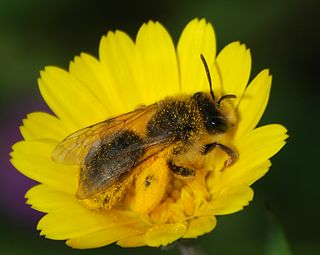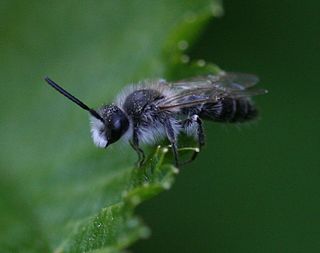
Ptelea trifoliata, commonly known as common hoptree, wafer ash, stinking ash, and skunk bush, is a species of flowering plant in the citrus family (Rutaceae). It is native to North America, where it is found in Canada, Mexico, and the United States. It is a deciduous shrub or tree, with alternate, trifoliate leaves.

A genet is a member of the genus Genetta, which consists of 14 to 17 species of small African carnivorans. The common genet is the only genet present in Europe and occurs in the Iberian Peninsula and France.

A least-concern species is a species that has been categorized by the International Union for Conservation of Nature (IUCN) as evaluated as not being a focus of species conservation. They do not qualify as threatened, near threatened, or conservation dependent.

The Andrenidae are a large, nearly cosmopolitan family of solitary, ground-nesting bees. Most of the family's diversity is located in temperate or arid areas. It includes some enormous genera. One of the subfamilies, Oxaeinae, is so different in appearance that they were typically accorded family status, but careful phylogenetic analysis reveals them to be an offshoot within the Andrenidae, very close to the Andreninae.

Andrena, commonly called the mining bee, is the largest genus in the family Andrenidae, and is nearly worldwide in distribution, with the notable exceptions of Oceania and South America. With over 1,300 species, it is one of the largest of all bee genera. Species are often brown to black with whitish abdominal hair bands, though other colors are possible, most commonly reddish, but also including metallic blue or green.

The Viverrinae represent the largest subfamily within the Viverridae comprising five genera, which are subdivided into 22 species native to Africa and Southeast Asia. This subfamily was denominated and first described by John Edward Gray in 1864.

The bee subfamily Andreninae is a nearly cosmopolitan lineage, with most of its diversity in one genus, Andrena, which contains over 1500 species. The remaining four genera in the subfamily only contain a total of 9 species.
Bat Conservation International (BCI) is an international nongovernmental organization working to conserve bats and their habitats through conservation, education, and research efforts.

Heteropoda cervina, commonly called the brown huntsman, is a large species of spider in the family Sparassidae often found in leaf litter in central Queensland, Australia. The species was first described by Ludwig Carl Christian Koch in 1875 as Sarotes cervinus.

Caracal is a genus of the subfamily Felinae in the family Felidae. Previously, it was considered to be a monotypic genus, consisting of only the type species: Caracal caracal, commonly called caracal.

The bearded miner bee is a species of miner bee in the family Andrenidae. It is found in Europe & Northern Asia and North America. Other common names include the long-lipped andrena and the sandpit mining bee.

Andrena bicolor, or Gwynne's mining bee, is a common and widespread Western Palearctic mining bee which is found over most of Europe as well as North Africa and the Middle East and which reaches eastwards into Siberia.

The tormentil mining bee is a species of mining bee from the family Andrenidae which has a Palearctic distribution.

Mentha gattefossei is a plant species in the genus Mentha, endemic to the Atlas Mountains of Morocco. It was first described by French botanist René Maire in 1922. Harvested for its essential oil, M. gattefossei has seen use in traditional medicine, pest control and as a food seasoning.












